7. AR QR code
7. AR QR code 7.1. Overview 7.2. Create ARTag 7.2.1. install software package 7.2.2. Create AR QR code 7.3, ARTag identification 7.3.1. Start the identification instance 7.3.2. launch file analysis 7.3.3. ar_track_alvar node 7.3.4. View node graph 7.3.5. View tf tree 7.3.6. View output information
7.1. Overview
wiki: http://wiki.ros.org/ar_track_alvar/
Source code: https://github.com/ros-perception/ar_track_alvar.git
Feature pack location: ~/yahboomcar_ws/src/yahboomcar_visual
ARTag (AR tag, AR means "augmented reality") is a fiducial marker system, which can be understood as a reference for other objects. It looks similar to a two-dimensional code, but its encoding system and two-dimensional code are still very large. The difference is mostly used in camera calibration, robot positioning, augmented reality (AR) and other applications. One of the most important functions is to identify the pose relationship between the object and the camera. An ARTag can be attached to the object, or an ARTag label can be attached to a plane to calibrate the camera. After the camera recognizes the ARTag, the position and pose of the tag in the camera coordinates can be calculated.
ar_track_alvar has 4 main functions:
- Generate AR tags of different sizes, resolutions and data/ID encodings.
- Recognize and track the pose of a single AR tag, optionally integrating kinect depth data (when kinect is available) for better pose estimation.
- Recognize and track poses in "clusters" consisting of multiple labels. This allows for more stable pose estimation, robustness to occlusion, and tracking of polygonal objects.
- The spatial relationship between tags in a bundle is automatically calculated using camera images so that users do not have to manually measure and enter tag positions in an XML file to use the bundle feature.
Alvar is newer and more advanced than ARToolkit, which has been the basis for several other ROS AR tagging packages. Alvar features adaptive thresholding to handle various lighting conditions, optical flow-based tracking for more stable pose estimation, and an improved label recognition method that does not slow down significantly as the number of labels increases.
7.2. Create ARTag
7.2.1. install software package
sudo apt install ros-melodic-ar-track-alvar 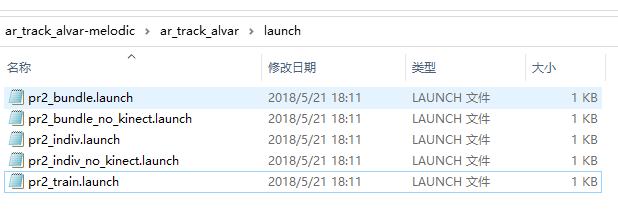
ar_track_alvar is an open source marker library that provides examples of pr2+kinect. The first use case of this package is to recognize and track the pose of (potentially) multiple AR tags, each of which is considered individually.
7.2.2. Create AR QR code
- Generate multiple labels in a row on an image
xxxxxxxxxxrosrun ar_track_alvar createMarker 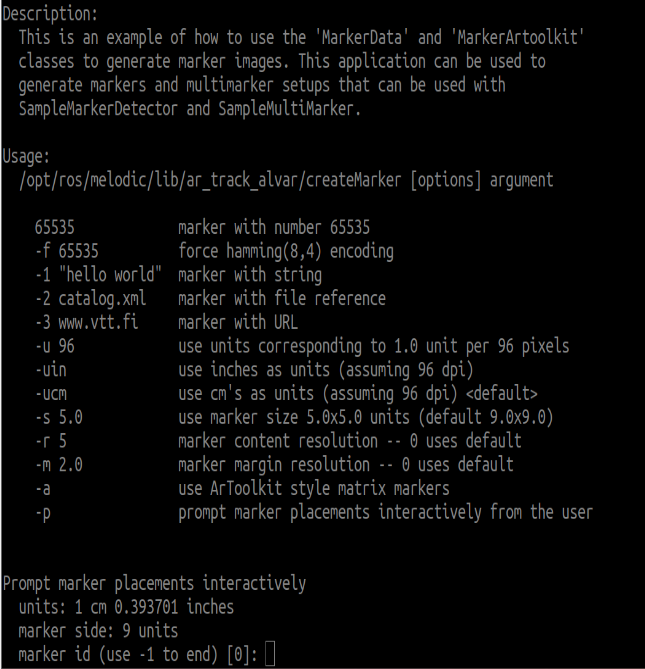
You can enter [ID] and location information here, and enter [-1] to end. One or more can be generated, and the layout can be designed by yourself.
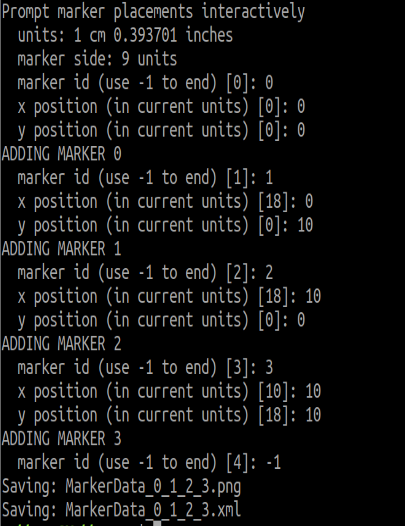
- generate a single number
Command+parameters directly generate digital pictures; e.g.
xxxxxxxxxxrosrun ar_track_alvar createMarker 11 rosrun ar_track_alvar createMarker -s 5 33 11: The number is the QR code of 11. -s: Specifies the image size. 5: 5x5 picture. 33: The number is the QR code of 33.
7.3, ARTag identification
Note: When starting the camera, you need to load the camera calibration file, otherwise it will not be recognized.
7.3.1. Start the identification instance
xxxxxxxxxxroslaunch yahboomcar_visual ar_track.launch open_rviz:=true - The open_rviz parameter is turned on by default.
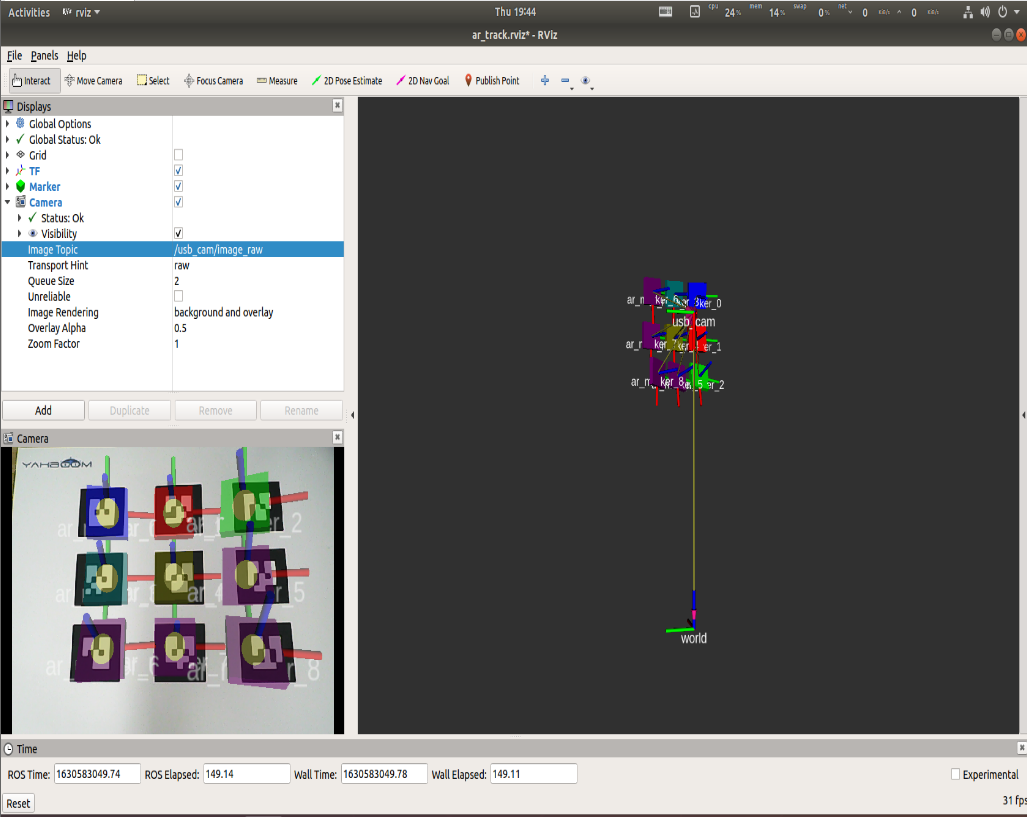
In rviz, you need to set the corresponding camera topic name.
- Image_Topic: The camera topic is [/usb_cam/image_raw].
- Marker: The display component of rviz, different squares display the location of the AR QR code.
- TF: The display component of rviz, used to display the coordinate system of AR QR code.
- Camera: The display component of rviz, which displays the camera screen.
- world: world coordinate system.
- usb_cam: Camera coordinate system.
7.3.2. launch file analysis
xxxxxxxxxx< launch > <!-- Set camDevice parameters, the default is USBCam --> < arg name = "open_rviz" default = "true" /> < arg name = "marker_size" default = "5.0" /> < arg name = "max_new_marker_error" default = "0.08" /> < arg name = "max_track_error" default = "0.2" /> <!-- Set camera image topic, camera internal reference topic, camera frame --> < arg name = "cam_image_topic" default = "/usb_cam/image_raw" /> < arg name = "cam_info_topic" default = "/usb_cam/camera_info" /> < arg name = "output_frame" default = "/usb_cam" /> <!-- start camera node --> < include file = "$(find usb_cam)/launch/usb_cam-test.launch" /> <!-- Set the correspondence between the camera coordinate system and the world coordinate system--> < node pkg = "tf" type = "static_transform_publisher" name = "world_to_cam" args = "0 0 0.5 0 1.57 0 world usb_cam 10" /> <!-- Start AR recognition node--> < node name = "ar_track_alvar" pkg = "ar_track_alvar" type = "individualMarkersNoKinect" respawn = "false" output = "screen" > < param name = "marker_size" type = "double" value = "$(arg marker_size)" /> < param name = "max_new_marker_error" type = "double" value = "$(arg max_new_marker_error)" /> < param name = "max_track_error" type = "double" value = "$(arg max_track_error)" /> < param name = "output_frame" type = "string" value = "$(arg output_frame)" /> < remap from = "camera_image" to = "$(arg cam_image_topic)" /> < remap from = "camera_info" to = "$(arg cam_info_topic)" /> </ node > <!-- start rviz --> < node pkg = "rviz" type = "rviz" name = "rviz" args = "-d $(find yahboomcar_visual)/rviz/ar_track.rviz" if = "$(arg open_rviz)" /> </ launch > Node parameters:
- marker_size (double) : The width (in centimeters) of one side of the border of the black square marker.
- max_new_marker_error (double): Threshold to determine when a new marker can be detected under uncertainty.
- max_track_error (double) : A threshold that determines how many tracking errors can be observed before markers disappear.
- camera_image (string) : Provides the image topic name used to detect AR tags. This can be monochrome or color, but should be an uncorrected image since correction is done in this package.
- camera_info (string) : Subject name that provides camera calibration parameters to correct images.
- output_frame (string) : Publish the coordinate position of the AR label in the camera coordinate system.
7.3.3. ar_track_alvar node
- Subscribed topic
| topic name | type of data |
|---|---|
| /camera_info | ( sensor_msgs/CameraInfo ) |
| /image_raw | ( sensor_msgs/Image ) |
- Published Topics
| topic name | type of data |
|---|---|
| /visualization_marker | ( visualization_msgs/Marker ) |
| /ar_pose_marker | ( ar_track_alvar/AlvarMarkers ) |
Provided tf Transforms
A single QR code: camera coordinate system → AR tag coordinate system
Multiple QR Codes: Provides a transformation from the camera coordinate system to each AR marker coordinate system (named ar_marker_x), where x is the marker's ID number.
7.3.4. View node graph
xxxxxxxxxxrqt_graph
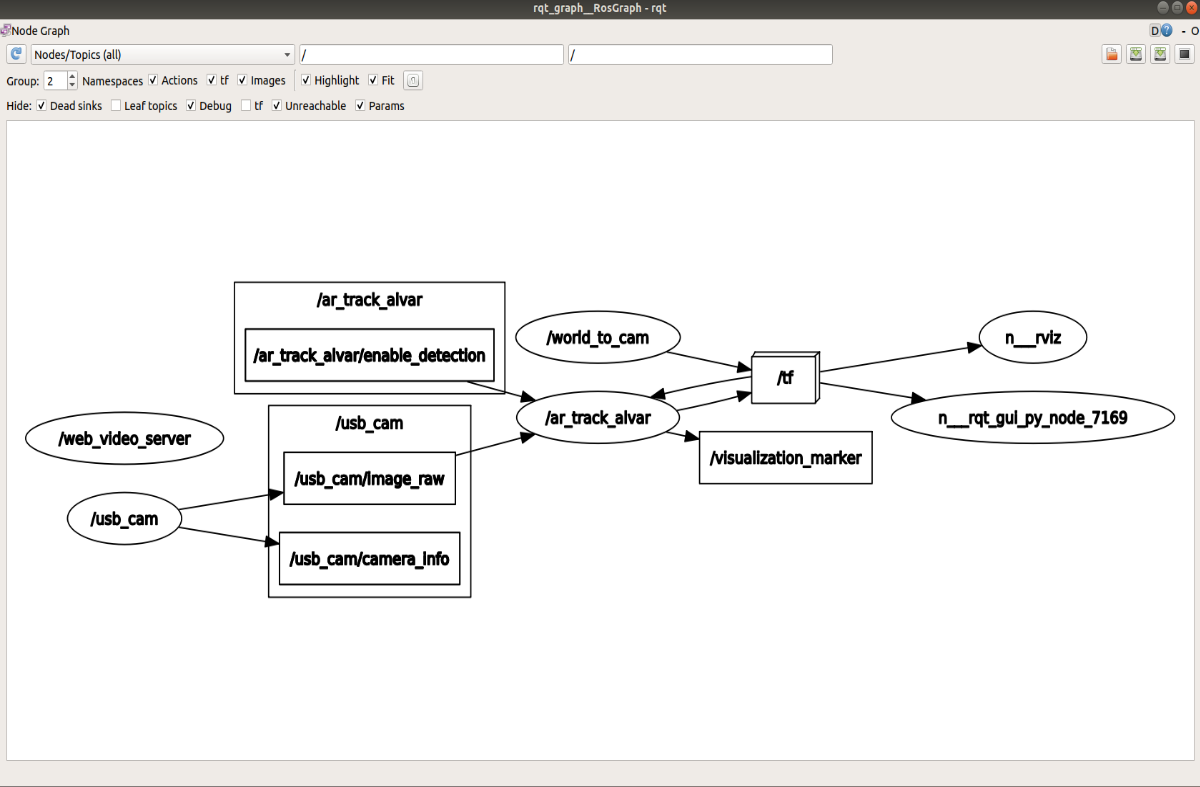
7.3.5. View tf tree
xxxxxxxxxxrosrun rqt_tf_tree rqt_tf_tree 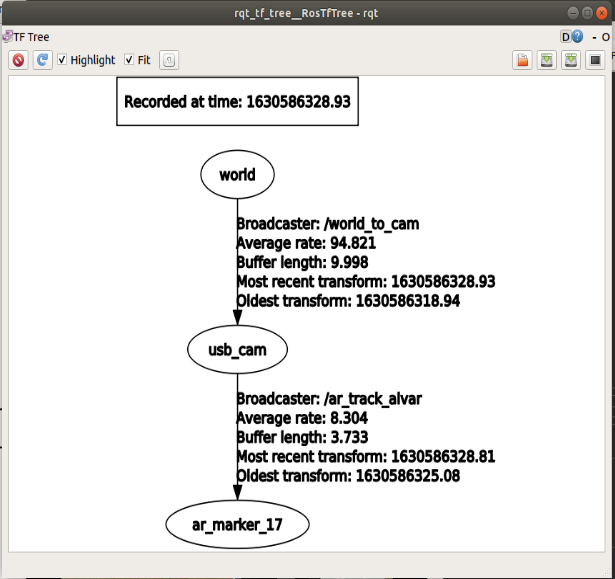
Through rviz, we can intuitively see the relative position of the QR code and the camera. The camera and world coordinate system are set by themselves.
7.3.6. View output information
xxxxxxxxxxrostopic echo / ar_pose_marker The display is as follows:
xxxxxxxxxx header: seq: 0 stamp: secs: 1630584915 nsecs: 196221070 frame_id: "/usb_cam" id: 3 confidence: 0 pose: header: seq: 0 stamp: secs: 0 nsecs: 0 frame_id: '' pose: position: x: 0.0249847882514 y: 0.0290736736336 with: 0.218054183012 orientation: x: 0.682039034537 y: 0.681265739969 with: -0.156112715404 in: 0.215240718735 - frame_id: the coordinate system name of the camera
- id: the recognized number is 3
- pose: pose of the QR code
- position: the position of the QR code coordinate system relative to the camera coordinate system
- orientation: the orientation of the QR code coordinate system relative to the camera coordinate system